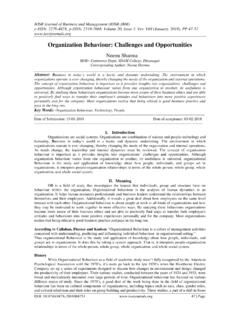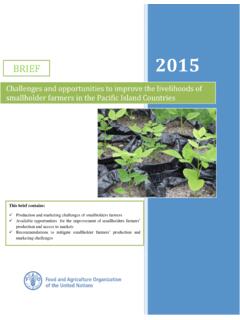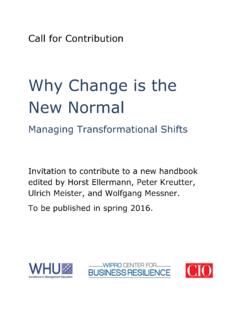Transcription of Global Dairy Sector – Trends and opportunities
1 Global Dairy Sector Trends and opportunitiesJanuary 2017 ContentsExecutive summary 03 opportunities and challenges in the Dairy Sector 08 Conclusions 3201 Executive summary01 Executive summary01 The Global Dairy Sector is currently going through a period of turbulence. Slowing demand from China, Russia s trade embargo and the removal of EU milk quotas, resulted in a period of excess supply and low prices. Despite this, the long term outlook for the Sector remains positive. Rising populations and changing diets are increasing demand for Dairy . As incomes rise and nations become increasingly urbanised, individuals tend to receive more of their calories from proteins (including Dairy ) as opposed to basic carbohydrates (mostly grains).
2 Global demand for Dairy is expected to increase by per cent per annum to 2020, largely driven by increasing urbanisation and rising incomes in emerging Summary01 Executive summarytechnologies can also help farmers expand production in a profitable and sustainable manner which is particularly important in the volatile post-EU quota consumer Trends such as the demand for healthy and clean label products, increased demand for functional foods and the growth in protein consumption will drive innovation in the Sector . While having strong technological capabilities is key to taking advantage of these Trends , it is not sufficient. The ability to identify and exploit consumer insights from local markets is also vital in generating increased value for consumers and higher margin products for producers.
3 These products must also be delivered in a safe and secure manner. The Dairy industry has seen a number of scandals in recent times, and firms must take measures to ensure that their supply challenges and opportunitiesWhile the Dairy Sector is currently dealing with a number of challenges , favourable long term consumer Trends and developing technologies provide a number of opportunities . This report looks at these challenges and opportunities at the producer, processor and retailer levels. It then outlines some of the overarching themes presented by these challenges and opportunities , and looks at how the Dairy industry as a whole needs to adapt. ProducersAt the producer level, emerging technologies and the datafication of agriculture are providing farmers with the potential to obtain quantifiable information to continuously measure and monitor farm operations and react accordingly.
4 Farmers who can complement these technologies with suitable operational and commercial practices could see profitability increase significantly. These chains are as secure as possible in order to maintain their customers trust. New technologies such as blockchain, a distributed and publicly-accessible ledger which records transactions in a tamper and revision-proof way, could potentially be used to track what goes into a product and who handles it along the number of Trends such as the growth of a healthy snacking culture, higher food consumption outside of the home and the growth of online and mobile shopping are changing the way food is being bought and consumed.
5 Dairy is at the forefront of these Trends as a convenient and relatively cheap source of protein. Retailers must adapt to these Trends through better use of technology and data to target customers with tailored offers and ensure that they can match supply and demand in smaller stores through better inventory summaryAdapting to the challenges and opportunitiesLooking across these Trends , it is clear that changing consumer demand patterns are impacting food production and consumption at all stages of the value chain. Deloitte research2 has identified a number of new value drivers for consumers when making their food choices. The Traditional value drivers of price, taste and convenience have been supplemented by Evolving drivers of health and wellness, safety, social impact and experience.
6 Overarching these drivers is a desire for transparency from food companies. 5,000 US consumers were surveyed as part of the research, roughly half of whom said their purchase decisions are significantly influenced by these Evolving drivers. What is more, these findings were pervasive across regions, age and income research therefore suggests that purchase decisions are increasingly based on product plus factors, such as specific ingredients, how the product was made, where it was made and corporate values of the manufacturer and retailer, amongst others. This requires that firms pay close attention to all aspects of food production from farm to fork. Health and wellness will certainly be a key consideration for innovation and new product development, but firms must think beyond individual product attributes to factors such as how the product is produced, the nature of the supply chain, etc.
7 Firms must also be able to communicate this holistic approach to consumers and provide them with relevant information in an open and transparent manner. This is particularly important in an era where misinformation and food safety issues have led to distrust amongst many consumers. These consumers now have access to more information than ever before, while social media provide platforms for their displeasure. 01 Executive summaryIn summary, meeting both Traditional and Evolving demands in a Dairy context will require producers, processors and retailers to provide consumers with nutritious, safe, convenient and value for money options. Producers must take advantage of the datafication of agriculture to expand production in a sustainable manner.
8 Processors will need to take advantage of their technical capabilities to develop new products, but also ensure that their production systems and supply chains are as safe and secure as possible. Retailers must make better use of technology and data to adapt to changing consumption patterns and offer consumers the food they want, when and where they want it. Furthermore, actors at all stages of the value chain will need to work hard to maintain the trust of a more demanding and empowered and opportunities in the Dairy SectorChallenges and opportunities in the Dairy SectorRunning Dairy farms on a professional (and in some cases industrial) basis has been commonplace for some time in a number of countries, most notably the US.
9 However, regardless of scale, evolving technologies and improved farm management practices will play a greater role on Dairy farms globally in the coming years. Successful farmers will need to focus on three key aspects to grow their enterprise in a sustainable and profitable manner. Producers The professionalisation of farmingTake advantage of new technologiesAt a technical level, emerging technologies and datafication of agriculture are providing farmers with quantifiable information to continuously measure, react, and monitor farm operations. This can provide farmers with the insight to ensure that all decisions contribute positively to farm efficiency and profitability.
10 Relatively simple technologies to assist with grass and herd management are becoming more widespread, and may signal the beginning of a wider trend. Various smartphone data applications, robotics (such as automated milking parlours), drones, micro-sensor technology and satellite systems are all likely to become more commonplace on the farms of the technology with suitable processesThese technical systems must be complemented by suitable operational processes to maximise their benefits. For example, while various technologies can be used to measure grass growth, it is up to the farmer to ensure that this data is used to rotate pastures in a way that optimises grass usage.


















